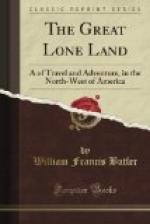Passing through Chicago, and going out by one of the lines running north along the shore of Lake Michigan, I reached the city of Milwaukie late in the evening. Now the city of Milwaukie stands above 100 miles north of Chicago and is to the State of Wisconsin what its southern neighbour (100 miles in the States is nothing) is to Illinois. Being, also some 100 miles nearer to the entrance to Lake Michigan, and consequently nearer by water to New York and the Atlantic, Milwaukie caries off no small share of the export wheat trade of the North-west. Behind it lie the rolling prairies of Wisconsin, Iowa, and Minnesota, the three wheat-growing states of the American Union. Scandinavia, Germany, and Ireland have made this portion of America their own, and in the streets of Milwaukie one hears the guttural sounds of the Teuton and the deep brogue of the Irish Celt mixed in curious combinations. This railway-station at Milwaukie is one of the great distributing points of the in-coming flood from Northern Europe. From here they scatter far and wide over the plains which lie between Lake Michigan and the head-waters of the Mississippi. No one stops to look at these people as they throng the wooden platform and fill the sheds at the depot, the sight is too common to cause interest now, and yet it is a curious sight this entry of the outcasts into the promised land. Tired, travel-stained, and worn come the fair-haired crowd of men and women and many children, eating all manner of strange food while they rest, and speaking all manner of strange tongues, carrying the most uncouth shapeless boxes that trunk-maker of Bergen or Upsal can devise—such queer oval red-and-green painted wooden cases, more like boxes to hold musical instruments than for the Sunday kit of Hans or Christian—clothing much soiled and worn by lower-deck lodgment and spray of




